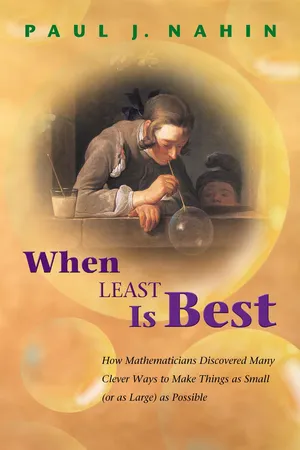![]()
1.
Minimums, Maximums,
Derivatives, and
Computers
1.1 Introduction
This book has been written from the practical point of view of the engineer, and so you’ll see few rigorous proofs on any of the pages that follow. As important as such proofs are in modern mathematics, I make no claims for rigor in this book (plausibility and/or direct computation are the themes here), and if absolute rigor is what you are after, well, you have the wrong book. Sorry!
Why, you may ask, are engineers interested in minimums? That question could be given a very long answer, but instead I’ll limit myself to just two illustrations (one serious and one not, perhaps, quite as serious). Consider first the problem of how to construct a gadget that has a fairly short operational lifetime and which, during that lifetime, must perform flawlessly. Short lifetime and low failure probability are, as is often the case in engineering problems, potentially conflicting specifications: the first suggests using low-cost material(s) since the gadget doesn’t last very long, but using cheap construction may result in an unacceptable failure rate. (An example from everyday life is the ordinary plastic trash bag—how thick should it be? The bag is soon thrown away, but we definitely will be unhappy if it fails too soon!) The trash bag engineer needs to calculate the minimum thickness that still gives acceptable performance.
For my second example, let me take you back to May 1961, to the morning the astronaut Alan Shepard lay on his back atop the rocket that would make him America’s first man in space. He was very brave to be there, as previous unmanned launches of the same type of rocket had shown a disturbing tendency to explode into stupendous fireballs. When asked what he had been thinking just before blastoff, he replied “I was thinking that the whole damn thing had been built by the lowest bidder.”
This book is a math history book, and the history of minimums starts centuries before the time of Christ. So, soon, I will be starting at the beginning of our story, thousands of years in the past. But before we climb into our time machine and travel back to those ancient days, there are a few modern technical issues I want to address first.
First, to write a book on minimums might seem to be a bit narrow; why not include maximums, too? Why not write a history of extremas, instead? Well, of course minimums and maximums are indeed certainly intimately connected, since a maximum of y(x) is a minimum of -y(x). To be honest, the reason for the book’s title is simply that I couldn’t think of one I could use with extrema as catchy as is “When Least Is Best.” I did briefly toy with “When Extrema Are xxx” with the xxx replaced with exotic, exciting, and even (for a while, in a temporary fit of marketing madness that I hoped would attract Oprah’s attention), erotic. Or even “Minimums Are from Venus, Maximums Are from Mars.” But all of those (certainly the last one) are dumb, and so it stayed “When Least Is Best.” There will be times, however, when I will discuss maximums, too. And now and then we’ll use a computer as well.
For example, consider the problem of finding the maximum value of the rather benign-looking function
Some students answer too quickly and declare the maximum value is 8, believing that for some value of
x the individual maximums of the two cosine terms will add. That is not the case, however, since it is equivalent to saying that there is some
such that
where
n and
k are integers. That is, those students are assuming there is an
such that
Thus,
or
or
But if this is actually so, then as
n and
k are integers we would have π as the ratio of integers, i.e., π would be a rational number. Since 1761, however, π has been known to be irrational and so there are no integers
n and
k. And that means there is no
such that
, and so
ymax(
x) < 8.
Well, then, what
is ymax(
x)? Is it perhaps
close to 8? You might try setting the derivative
of y(
x) to zero to find
, but that quickly leads to a mess...











